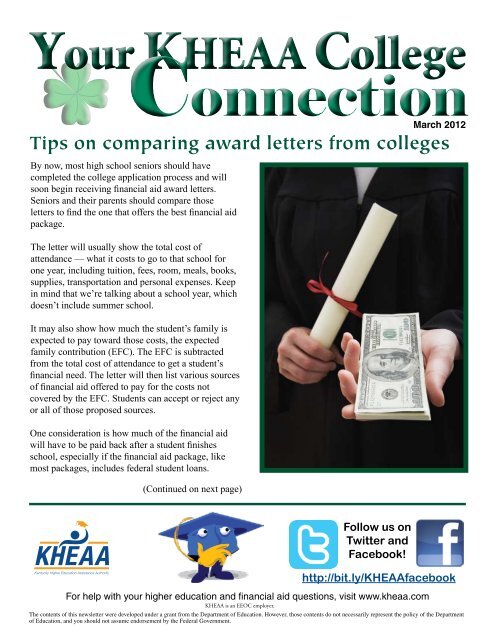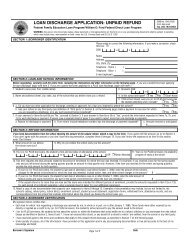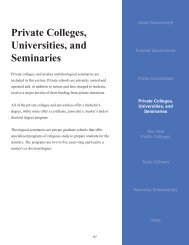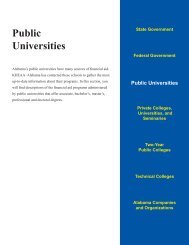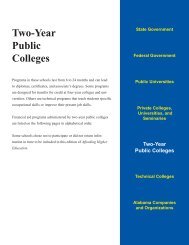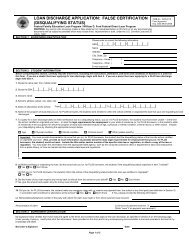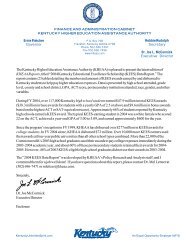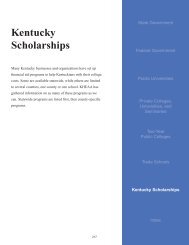School and package comparison - KHEAA
School and package comparison - KHEAA
School and package comparison - KHEAA
You also want an ePaper? Increase the reach of your titles
YUMPU automatically turns print PDFs into web optimized ePapers that Google loves.
March 2012<br />
By now, most high school seniors should have<br />
completed the college application process <strong>and</strong> will<br />
soon begin receiving financial aid award letters.<br />
Seniors <strong>and</strong> their parents should compare those<br />
letters to find the one that offers the best financial aid<br />
<strong>package</strong>.<br />
The letter will usually show the total cost of<br />
attendance — what it costs to go to that school for<br />
one year, including tuition, fees, room, meals, books,<br />
supplies, transportation <strong>and</strong> personal expenses. Keep<br />
in mind that we’re talking about a school year, which<br />
doesn’t include summer school.<br />
It may also show how much the student’s family is<br />
expected to pay toward those costs, the expected<br />
family contribution (EFC). The EFC is subtracted<br />
from the total cost of attendance to get a student’s<br />
financial need. The letter will then list various sources<br />
of financial aid offered to pay for the costs not<br />
covered by the EFC. Students can accept or reject any<br />
or all of those proposed sources.<br />
One consideration is how much of the financial aid<br />
will have to be paid back after a student finishes<br />
school, especially if the financial aid <strong>package</strong>, like<br />
most <strong>package</strong>s, includes federal student loans.<br />
(Continued on next page)<br />
For help with your higher education <strong>and</strong> financial aid questions, visit www.kheaa.com<br />
<strong>KHEAA</strong> is an EEOC employer.<br />
Follow us on<br />
Twitter <strong>and</strong><br />
Facebook!<br />
http://bit.ly/<strong>KHEAA</strong>facebook<br />
The contents of this newsletter were developed under a grant from the Department of Education. However, those contents do not necessarily represent the policy of the Department<br />
of Education, <strong>and</strong> you should not assume endorsement by the Federal Government.
(Continued from previous page)<br />
If the <strong>package</strong> isn’t enough to pay all expenses,<br />
students may be looking at a private education loan.<br />
Comparison shopping is a must in that case. Visit<br />
kheaamarketplace.com to find the best private loan<br />
for you.<br />
Be sure to weigh all options before deciding on a<br />
school.<br />
The chart below will help you compare both schools<br />
<strong>and</strong> school <strong>package</strong>s. Use your award letters that<br />
you receive from colleges’ financial aid offices<br />
<strong>and</strong> the Student Aid Report (SAR) that you receive<br />
after filling out the FAFSA to fill out this chart to<br />
compare the schools <strong>and</strong> financial aid <strong>package</strong>s you<br />
are considering. The sample column will give you<br />
an idea of how to fill in the needed information.<br />
Sometimes the most expensive schools have<br />
scholarships that will bring them in line with others.<br />
So don’t limit yourself; consider all your choices<br />
<strong>and</strong> compare.<br />
<strong>School</strong> <strong>and</strong> <strong>package</strong> <strong>comparison</strong><br />
Sample <strong>School</strong> A <strong>School</strong> B<br />
Need Calculation<br />
$3,000<br />
800<br />
6,200<br />
1,800<br />
1,200<br />
13,000<br />
-1,000<br />
12,000<br />
Tuition <strong>and</strong> Fees<br />
Books <strong>and</strong> Supplies<br />
Room <strong>and</strong> Board<br />
Transportation<br />
Personal Expenses<br />
Total Cost of Attendance (varies from school to school)<br />
Minus Estimated Family Contribution (remains the same)<br />
Financial Need<br />
Financial Aid Package<br />
$3,000<br />
1,500<br />
0<br />
500<br />
1,700<br />
0<br />
2,000<br />
3,300<br />
0<br />
12,000<br />
0<br />
Federal Pell Grant<br />
College Access Program Grant<br />
Kentucky Tuition Grant<br />
Other Grants/Scholarships<br />
Kentucky Educational Excellence Scholarship (KEES)<br />
Work-Study<br />
Federal Perkins Loan<br />
Federal Stafford Loan<br />
Other Loans<br />
Total Financial Aid Package<br />
Unmet Need (Financial Need minus Total Financial Aid Package)<br />
2
Adults returning to school can find lots of help<br />
Are you an adult thinking about returning to college or<br />
enrolling for the first time? Or perhaps you’re thinking<br />
about taking courses online. If you are, Kentucky has<br />
resources that can make the transition to college an<br />
easier one. The state also offers financial aid programs<br />
to help you.<br />
<strong>KHEAA</strong> publishes Adults Returning to <strong>School</strong>,<br />
available FREE from adult education centers or<br />
directly from <strong>KHEAA</strong>. E-mail publications@kheaa.<br />
com, <strong>and</strong> we’ll mail you a copy. The entire book is<br />
online at www.kheaa.com, <strong>and</strong> a copy is sent to every<br />
public library in the state. Adults Returning to <strong>School</strong><br />
has information about entrance exams, financial aid<br />
programs, student loans <strong>and</strong> Kentucky schools.<br />
Another <strong>KHEAA</strong> book, Affording Higher Education,<br />
lists over 5,000 student aid programs available to<br />
Kentucky students at Kentucky colleges. Copies are<br />
sent to all public libraries, <strong>and</strong> the book is searchable<br />
online on www.kheaa.com. That way you can find<br />
programs specifically for adult students.<br />
Adults Returning<br />
To <strong>School</strong><br />
2011–2012<br />
Guide to<br />
Higher Education<br />
for Adult Students<br />
Provided by the Kentucky Higher Education Assistance Authority<br />
Adult students are eligible for most state financial<br />
aid programs, as long as they meet the general<br />
requirements. For full details, go to www.kheaa.<br />
com, click on “Adult Learners,” then click on<br />
the links to grants, scholarships <strong>and</strong> financial aid<br />
programs.<br />
College grants available for adult students<br />
Adult Kentuckians who are interested in taking college<br />
classes may be eligible for a Go Higher Grant administered<br />
by <strong>KHEAA</strong>.<br />
Go Higher Grants are available to adults age 24 or older who<br />
are enrolled less than half-time at a participating Kentucky<br />
college or university. Applicants must show financial need.<br />
The maximum award amount is $1,000 per academic year. It<br />
covers tuition <strong>and</strong> a book allowance of $50 per credit hour.<br />
To be considered for a grant, students must complete a Go<br />
Higher Grant application <strong>and</strong> the FAFSA. Grant applications<br />
are available at www.kheaa.com. The FAFSA can be<br />
submitted online at www.fafsa.gov. Students are encouraged<br />
to apply as early as possible because funding is limited.<br />
3
Federal student aid programs can help pay college costs<br />
The federal government sponsors numerous financial aid<br />
programs that can help students <strong>and</strong> their parents pay college<br />
expenses. Below is a brief summary that describes some of<br />
the more common federal grant <strong>and</strong> loan programs. Grants<br />
generally don’t have to be repaid, but loans do.<br />
• Federal Pell Grant. Pell Grants provide up to $5,550<br />
per year for undergraduates with financial need.<br />
• Federal Supplemental Educational Opportunity<br />
Grant. These provide up to $4,000 per year for<br />
undergraduate students who have exceptional financial<br />
need.<br />
• Federal Perkins Loan. These loans are for students<br />
with exceptional financial need. Undergraduates can get<br />
up to $5,500 per year, while graduate students can get<br />
up to $8,000 per year.<br />
• Federal Stafford Loan. Stafford Loans are available<br />
to undergraduate, graduate <strong>and</strong> professional students.<br />
The amount students may borrow varies depending<br />
upon their year in school.<br />
• Federal PLUS Loan. Parents of dependent<br />
undergraduate students may qualify for PLUS Loans, depending on the parents’ credit ratings. The<br />
amount available depends on how much other financial aid the student receives. Graduate students may<br />
apply for PLUS Loans if they have exhausted all of their Stafford Loan eligibility.<br />
The Free Application for Federal Student Aid (FAFSA) is used to apply for all of these programs. Families<br />
seeking a PLUS Loan must also submit a separate application.<br />
New booklet will help freshmen adjust to first year at college<br />
Kentucky students headed to college in the fall have a<br />
new resource to help them through their first year on<br />
campus.<br />
Surviving College, a guide to students’ first year, is now<br />
available free from <strong>KHEAA</strong>.<br />
A guide to GET You through your freshman year<br />
The 36-page booklet includes the following sections:<br />
• Majors <strong>and</strong> class schedules.<br />
• Staying healthy <strong>and</strong> safe on campus.<br />
• Learning styles <strong>and</strong> study tips.<br />
• Campus life.<br />
• Financial basics.<br />
To order a copy of Surviving College, e-mail<br />
publications@kheaa.com, call (800) 928-8926, ext.<br />
6-7372 or order online at http://bit.ly/<strong>KHEAA</strong>orderform.<br />
4
KESPT offers free activity book for children<br />
Parents who want to get younger children thinking about college have<br />
an excellent resource in an activity book from the Kentucky Education<br />
Savings Plan Trust (KESPT), a college savings program administered by<br />
<strong>KHEAA</strong>.<br />
The activity book, called “I Can Go to College, Too,” has child-friendly<br />
text <strong>and</strong> fun things for children to do. They can try their h<strong>and</strong>s at a saving<br />
for college maze, a word search puzzle, a connect the dots picture <strong>and</strong><br />
other activities.<br />
KESPT is the state’s official college saving plan. It is managed by TIAA-<br />
CREF Tuition Financing Inc., a leading financial services provider.<br />
For more information about KESPT, visit www.kysaves.com or call<br />
1.877.598.7878.<br />
To order a copy of the activity book, go to http://bit.ly/<strong>KHEAA</strong>orderform.<br />
Dream Out Loud Challenge reminder<br />
Just a reminder that Kentucky students in grades K-6 have a<br />
chance to win $1,500 toward college <strong>and</strong> $500 for their school<br />
in the Dream Out Loud Challenge. Students are invited to<br />
answer the question “How will I change the world after I go to<br />
college?”<br />
Nine winning entries will be selected by a panel of judges.<br />
One winner will be chosen from each of three categories in<br />
grades K-2, grades 3-4 <strong>and</strong> grades 5-6. The categories are:<br />
• Drawing.<br />
• Poem or essay.<br />
• Video.<br />
Each winning student will receive a $1,500 college savings<br />
account, <strong>and</strong> their schools will win $500. The contest runs<br />
through March 16. Entries must be postmarked by March 16<br />
<strong>and</strong> received by March 23.<br />
The challenge is sponsored by KESPT.<br />
Visit www.kysaves.com to learn more about the challenge,<br />
including official rules <strong>and</strong> a complete description of entry<br />
requirements. No purchase necessary. Void where prohibited.<br />
5
Mary Jo Young Scholarship update<br />
(Note: An article on this scholarship was in the<br />
February Your <strong>KHEAA</strong> College Connection. This<br />
contains updated information.)<br />
Kentucky high school students may qualify for a<br />
scholarship to help pay for dual credit classes taken<br />
at a Kentucky college or university or for Advanced<br />
Placement (AP) courses taken through the Kentucky<br />
Virtual High <strong>School</strong>.<br />
The Mary Jo Young Scholarship, named for a<br />
former member of the Board of Directors of<br />
<strong>KHEAA</strong>, is available to Kentucky students in<br />
grades 9 through 12. Priority is given to low-income<br />
students. The scholarship provides up to $405 per<br />
class toward tuition for up to two classes each<br />
semester <strong>and</strong> up to $125 per class for textbooks.<br />
Scholarships can only be used in the fall <strong>and</strong> spring<br />
semesters.<br />
A contract is a written agreement between two<br />
or more parties in which an offer is made <strong>and</strong><br />
accepted. If you’re thinking about signing a<br />
contract, make sure you underst<strong>and</strong> it.<br />
If you rent an apartment or have your own cell<br />
phone plan, you’ve probably signed a contract. If<br />
you’ve taken out a federal student loan, you entered<br />
a contract when you signed your Master Promissory<br />
Note.<br />
The application is available on www.kheaa.com,<br />
linked from http://www.kheaa.com/website/kheaa/<br />
mjyoung?main=1 <strong>and</strong> the application period runs<br />
through May 1.<br />
Senior year planner<br />
March<br />
❏ Submit mid-year grades if the colleges you’ve<br />
applied to require them.<br />
❏ Send in any required deposits.<br />
❏ If you’ve been accepted by more than one college<br />
but haven’t heard from your first choice, contact<br />
that school about a decision before you make any<br />
nonrefundable deposits to other schools.<br />
❏ If you’ve decided on which school to attend,<br />
notify that college of your decision. Let any other<br />
colleges that have accepted you know about your<br />
decision.<br />
Be sure you underst<strong>and</strong> contracts before signing<br />
Since a contract sets out in detail what each party<br />
is obligated to do for the other party, you should<br />
read each contract thoroughly <strong>and</strong> ask questions.<br />
If one of the parties agrees to make a change in the<br />
contract, make sure the change is in writing. Get<br />
all your questions answered before you sign the<br />
contract, <strong>and</strong> keep a copy after you have signed. In<br />
some cases, it might make sense to have an attorney<br />
look over the contract before you sign it.<br />
Consumer protection laws let you cancel some<br />
contracts within three days of signing. Before you<br />
6<br />
sign any contract, find out if you have that option.<br />
If you don’t, your options of getting out of the<br />
contract are limited.<br />
If someone uses high-pressure tactics to get you to<br />
sign a contract, consider that a warning sign that<br />
things may not be on the up <strong>and</strong> up. When that<br />
happens, walk away.


